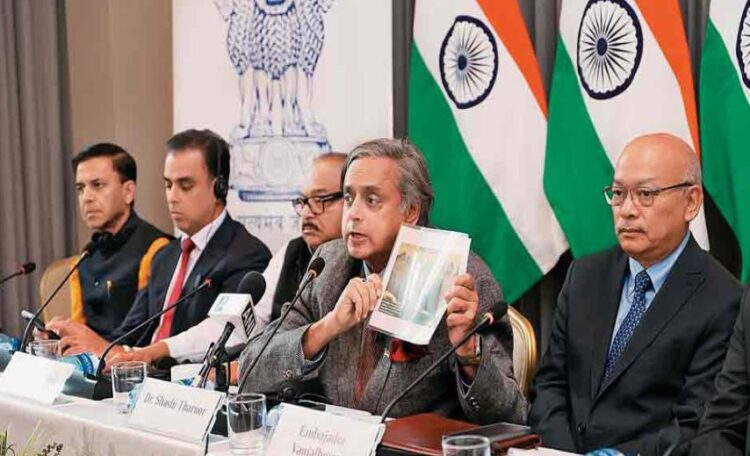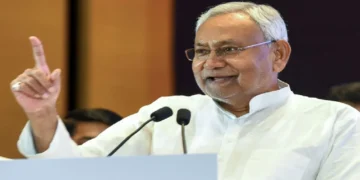India sent all -party delegation to 33 countries to put Pakistan back into the gray list
India has launched a solid diplomatic and financial campaign to bring Pakistan back to the Gray list of Financial Action Task Force (FATF). It is an inter-governmental surveillance institution in Paris, which sets a global standard for dealing with money laundering and terrorism funding. This pressure from India focuses on a wide dosier, which is to be introduced during the full session of FATF in June, with financial transactions, intelligence assessments and inputs of the international agency. It is aware that it is known that there is a continuous information about the continuous relationship between Pakistan’s government institutions and terrorist groups recorded in the United Nations list, which is opposite to Pakistan’s promise, on the basis of which it was extracted from the gray list in October 2022.
The dosier reportedly states that Pakistan has mocked the leading FATF norms related to anti-land laundering (AML) and anti-terrorism financing (CTF). According to a report, arguments will be presented that despite the promise of financial transparency, Pakistan has continuously continued financial assistance to groups like Lashkar-e-Taiba and Jaish-e-Mohammed.
Parallel to this, India is also urging financial institutions like International Monetary Fund (IMF) and World Bank to re -evaluate the financial assistance to Islamabad. The Government of India has presented data that the help taken to put under the item of economic reform has probably been engaged in modernization of the army and financing terrorism. According to a report, India’s analysis suggests that Pakistan’s weapons imports have increased by 20 percent during the period of IMF funding between 1980 and 2023.
Foreign Secretary Vikram Misri (Right) is in Washington to put pressure on the gray list. America’s consent will be very important for this
India’s Foreign Secretary Vikram Misri is also in Washington for all these purposes. Obviously, America’s consent will be very important for this. The inclusion of a gray list can greatly affect the economy of a country, which can increase the investigation of financial transactions, reduce the trust of investors and it can be difficult to get international debt and help. Countries with black list are outside these items.
Pakistan was first placed in 2008 and then in 2012, especially in 2012, terrorist groups like Lashkar-e-Taiba and Jaish-e-Mohammed were kept in gray-list to prevent financial help. He was under surveillance till 2015. Then, after an increased international pressure after the Pulwama terror attack, he was again kept in the gray-list in 2018.
Over the next four years, FATF released a series of 34 action points, under which Islamabad needed to prosecute the United Nations nominated terrorists, strengthen financial monitoring and improve domestic laws. In October 2022, member countries of FATF, including India, unanimously voted in favor of removing Pakistan from the gray list.
Foreign Ministry spokesman Arindam Bagchi said, “It is in the global interest that Pakistan should continue to be reliable, proved and continuously action against financial assistance to terrorists arising from its land.” However, the notion has changed after the Pahalgam terror attack on 22 April this year.
Now India argues that Pakistan has not fulfilled its commitments after 2022 and has continued to check for groups like Lashkar-e-Taiba and Jaish-e-Mohammed responsible for 26/11 Mumbai attacks and attacks like Pulwama bomb blasts. According to Indian officials, a comprehensive doseer has been prepared for the full session of the FATF to be held in June, with financial intelligence information detecting public funds and foreign aid, the budget analysis exposing Pakistan’s increased defense spending amidst economic crises, data analysis from international colleagues, which indicates the misuse of financial assistance for alleged military expansion.
Diplomatic initiative after Pahalgam
Most international institutions and countries condemned the violence and praised the struggle after the Pahalgam terror attacks and counter-military action, and conflict, but most of them did not directly convict Pakistan. That is why India sent all -party delegations to 33 countries in Europe, Gulf countries, Africa, America, etc. to present their case. In Bahrain, AIMIM MP Asaduddin Owaisi said that Pakistan is a “failed state”, which raises and chews the terrorists, so it should re -put in the FATF gray list.
In Washington, Congress MP Shashi Tharoor, in a discussion with American policy analysts, called Pakistan a “revisionist country” and warned that any attack beyond the Line of Control could lead to a major war. Shashi Tharoor’s team also went to Columbia, etc., where the government statement expressed grief for both of them and those killed in Pakistan in military action. Later Tharoor said that the Columbia government has agreed to withdraw the statement of expressing grief towards those killed in Pakistan, but no official information came.
Former Foreign Minister Salman Khurshid said in Seoul that after the recent assembly elections, there is an atmosphere of relatively peace in Jammu and Kashmir, to break this, Pahalgam terrorist action was taken by Pakistan. Shiv Sena MP Srikanth Shinde met the leaders of the UAE and the Democratic Republic of Congo. However, what is the effect of these tours, it has to be seen, because hardly any country’s government circles could be discussed. In America, he was not invited to the Trump administration or any official forum.
Then, what will be the results of putting Pakistan in the gray-list again? Pakistan has suffered a lot of economic loss due to the first gray list. A study by a transfer of the think tank-based think tank-based on Islamabad estimated that the gray-list from 2008 to 2019 caused a total loss of about $ 38 billion GDP, caused by consumption, export and decrease in foreign investment. Additionally, Pakistan’s banking system will face a tough investigation, which made international transactions slow and expensive.
Returning to the gray list may affect Pakistan’s international credibility and bilateral relations may cause tension, especially at a time when Pakistan is doing the IMF agreement. In May 2025, the IMF approved a new installment of $ 1 billion to Islamabad. This financial assistance is associated with the condition of infrastructural reforms, including strict legislative monitoring of the national budget, equality in territorial taxes and curbing fiscal deficit, etc. In such a situation, it can make it difficult for Pakistan to join the gray list. But it all depends on how effective India’s efforts are. At present, Pakistan is also getting help from many countries and the World Bank. The World Bank has recently agreed to help $ 4 billion.
What is FATF and its gray list?
The Financial Action Work Force (FATF) was founded in 1989 by G7 countries Canada, France, Germany, Italy, Japan, Britain and America, so that global standards are set to deal with the dangers of money laundering, terrorism and the dangers of international financial system. Today 39 countries are its members and more than 200 affiliated countries. His recommendations are valid.
Two public lists of FATF are gray (brown or gray) and black (black).
The gray list is put to those countries that have strategic and policy shortcomings but make concrete promises to take action against money laundering and terrorism. Currently, there are countries like Lebanon, Haiti, South Sudan, South Africa and Monaco in this list.
Black list puts serious flaws and heavy risk countries that do not have any reliable scheme. There are only three countries in this list: Myanmar, North Korea and Iran.





